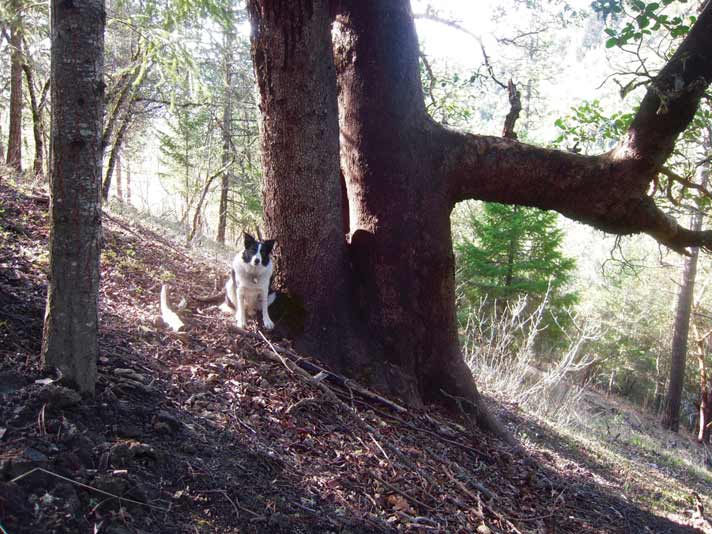A wiser man than most once observed that if one can’t see the forest for the trees, then maybe one should focus on just one tree and the forest will come into view in all its splendor. And that is the essence of living in the moment…being aware of the one thing you can see, reveling in its being, while the quiet subconscious mind deals with the forest beyond.
I’d like to introduce you to a few trees in Forest Park that deserve your consideration as you wander along, exploring. Be it a massive fire-scarred madrone, a singularly-proud specimen of big-leaf mapleness, or the spreading branches of a creekside Pacific yew, it’s the journey that leads you through the forest that kindles the wild spirit in you. Other wonders will also catch your eye, surely.
Hiking up “Ponderosa Snag Trail” from the park entrance leads one through an oak savanna before climbing out into a fire-scarred area. Here, below the trail, near the large dead namesake snag, one finds a massive madrone. Its spreading branches bear white blossoms in the spring and orange berries in the fall – a drunken feast for robins after the berries ferment. The Madrone’s tell-tale orange bark sheds in the summer, along with the older leaves, creating a crunchy hiking bed. This madrone bears the scars of multiple fires and one can only wonder at its age. Unlike the ‘Octopus’ madrone near the “Jane Naversen Trail” in the Britt Woods, this monster tree has many stems joining at ground level. It is certainly a tree to behold on this short loop hike from parking area P-1. See map on page 34.
The spreading big-leaf maples are most common along “Jackson Creek Nature Trail,” often spanning canyon-wide. Their heavy moss-covered branches grow their own gardens of ferns. Plate-size leaves turn bright yellow in autumn, tumbling to the forest floor in thick blankets. Bright fall days reflect brilliant gold. Eyes squint in the corridors between the massive trunks, struggling to pick out the outlines of the trail so heavily carpeted. Such a wonderful time to be afoot, feeling the slight tug of each massive leaf in passing. To declare one maple more massive or more splendorous is futile. Each seems more spectacular than the last.
The Pacific yew I have in mind is home to Pacific wrens. In the shade of this yew, found appropriately on “Shade Creek Trail,” is a park bench. What a pleasure it is to sit on that bench and listen to the melodious song of the wrens! Year-round residents, the wrens flit up and down “Norling Gulch” finding bugs where they may, singing at their labors. Like other yews in the park, this one is close to water. At the tip of the branches, one can often find the small red fruit, or aril: an enticement to birds to spread the seeds widely.
Wherever you find yourself in Forest Park, take a moment to notice the trees in general. Because of the orientation of the ridges and canyons and the elevation difference between the park entrance and the ridge tops, you pass through a variety of woodland realms. It’s what makes Forest Park what it is. With so many miles of trails to explore, head out, and don’t be concerned if you truly can’t see the forest for the trees.

 Trail Talk is a monthly column by Clayton Gillette about hiking the Jacksonville Woodlands trail system. For more information, please visit the Jacksonville Woodlands Association website at
Trail Talk is a monthly column by Clayton Gillette about hiking the Jacksonville Woodlands trail system. For more information, please visit the Jacksonville Woodlands Association website at